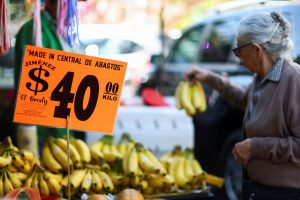The protection and good nutrition of crops has been one of the greatest concerns of the agricultural sector, since the use of inputs such as fertilizers, insecticides, pesticides, among others, requiree some basic tasks to guarantee productivity in the field.
(See: Low milk consumption and other keys to understanding the crisis in the dairy sector)
María Helena Latorre, executive director of the Andi Chamber of Procultures, spoke with Portafolio about the programs they have been carrying out, as well as well as the capacity that Colombia has to produce its own agricultural inputs.
What has the Chamber of Procultures been working on?
We work on several fronts to promote optimal crop protection and nutrition, especially in small and medium-sized farmers, as well as to connect beekeeping with agriculture.
We know that feeding and properly caring for crops against pests, diseases and weeds increases crop productivity, but it is also definitive to put into practice Good Agricultural and Beekeeping Practices to achieve sustainable, responsible agricultural development that contributes to the food security of Colombia, with safe and sufficient food.
(See more: Bayer plans to open a biotechnology improvement center in Colombia)
Regarding the nutrition and protection industry, what challenges do you identify?
The main one is to ensure that farmers provide optimal protection and nutrition for their crops, since according to the FAO, up to 40% of crops are lost in the world due to pests. This, of course, has an impact on food security, a vital issue for Colombia.
Optimal protection and nutrition ensures better productivity, in addition to taking care of the environment through the implementation of Good Agricultural Practices.
(Also read: Milk processors ask Minagricultura for measures to address the crisis in the sector)
A series of environmental care regulations are coming, including the reduction of agrochemicals. What alternatives are you taking?
Integrated Pest and Disease Management (IPM) aims to combine the various technologies available for crop protection. In that sense, the issue is not about using fewer agrochemicals, but about using the exact doses recommended by agronomists, and adding alternatives such as, for example, bioinputs.
And it must be mentioned that, through the implementation of Good Agricultural Practices, rural producers can use the various alternatives without causing damage to the environment.
María Helena Latorre, director of the Andi Pro-Cultivation Chamber
Courtesy
Is Colombia capable of producing its own inputs?
Yes, there are 13 production plants in the country, mainly in Atlántico and Bolívar, due to the location of the ports; There are also in Valle del Cauca, Antioquia and Cundinamarca.
Regarding crop protection such as insecticides, fungicides and herbicides, Colombia imports active ingredients and the formulations that are marketed nationally and internationally are made here.
(See more: Alpina and Alquería reduce milk purchases and worsen the crisis in the dairy production sector)
In crop nutrition, simple fertilizers, physical mixture fertilizers and formulation fertilizers, the main elements (urea, potassium, phosphorus) are imported and physical mixtures and/or formulations, innovations are made in plants.
Colombia, thanks to the companies present in its territory, exports to nearly 50 countries, and is able to meet the demand for bioinputs, since these companies have portfolios in other latitudes.
(Read: Uncertainty grows in agriculture due to the use of parafiscal funds for economic reactivation)
What trends do you currently identify?
Integrated Pest and Disease Management is decisive, because it allows combining the different alternatives that exist for crop protection. Bioinputs are gaining popularity and ground every day, but it is key to understand that they cannot do all the work alone. A very exemplary case is that of Sri Lanka, which wanted to convert all of its agriculture to production without chemical synthesis inputs, which ended in a total disaster.
And in terms of nutrition, it is key to get our act together, because in Colombia we starve crops, and we must reverse this situation if we want to increase productivity and improve the performance of the agricultural economy in the country.

Fertilizers
iStock
What companies make up the Chamber?
In crop protection and nutrition there are: Adama, BASF, Bayer, Corteva, FMC, Gowan, Sumitomo, Syngenta, Precisagro, UPL and Yara.
(Read: Agriculture in Colombia: characterization and typologies of those who provide us with food)
Taking into account the economic situation of the country, how do you see the investment environment of these multinationals?
Colombia is a very important market for this industry, so the commitment of these companies to the country is long-term. Gowan recently opened a new plant in Rionegro, Antioquia, an example that these companies believe in the country and its people.
(See also: Minister of Agriculture presents plan to confront the La Niña phenomenon)
What developments and innovations should be worked on for the sector?
Companies in the sector are constantly evaluating new products for the protection and nutrition of crops, which are effective and environmentally friendly. And I’m not just talking about chemical synthesis inputs, here I’m also talking about bioinputs, which as I mentioned before, are gaining ground in the industry.

Fertilizers
iStock
In terms of prices, how have they been behaving?
In the first quarter of this year, according to the data provided by Upra, there is a clear downward trend in these inputs, with fertilizers and herbicides recording the greatest reductions, with decreases of 6.02% and 2.35%. %, respectively.
Here it is key to remember that having production plants within Colombia is definitive to better weather the fluctuations in international prices, something that was clearly evident last year, when due to the beginning of the conflict between Russia and Ukraine the effects The prices of these inputs in Colombia were lower than in other latitudes.
(Read: ABC of the reasons why the price of fertilizers continues to fall)
What expectations do you have for the rest of the year?
This year we hope to exceed 10,000 beneficiaries of the Procultivos programs, which are free and reach the entire national territory. In addition to CuidAgro and Mentes Fértiles, which aim to provide the tools for optimal protection and nutrition of crops, the Procultivos chamber offers alliance sessions between farmers and beekeepers, the Good Beekeeping Practices workshop, and virtual courses for agricultural input farms. and graduates to train more people in crop protection and nutrition.
As more rural producers do better protection and nutrition of their crops and work closely with beekeepers, it is more likely that Colombian agriculture will have greater growth and aim for sustainable and environmentally friendly agriculture.



![[Img #74675]](https://thelatestnews.world/wp-content/uploads/2024/12/They-discover-a-new-class-of-X-ray-sources-in-the-150x150.jpg)











Add Comment